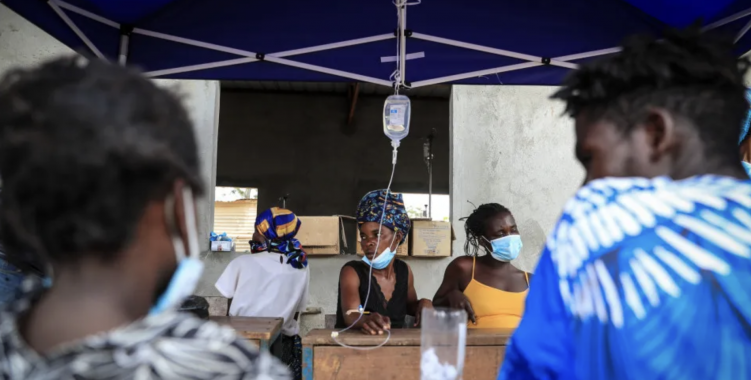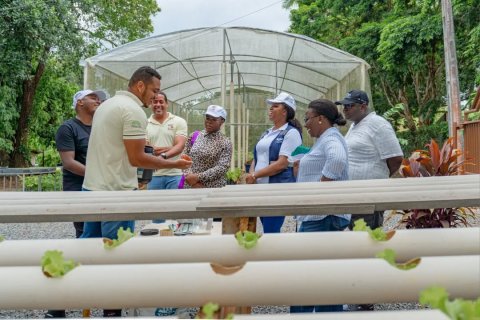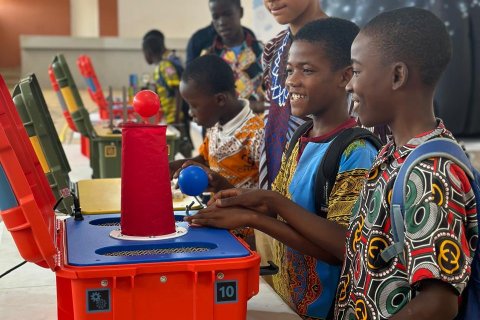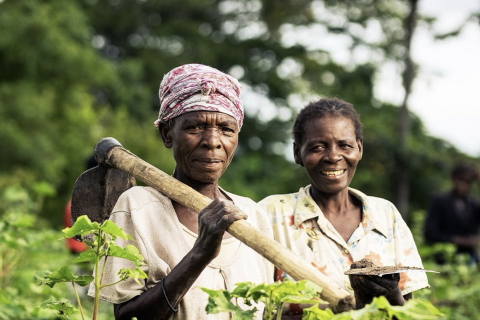In just two days, 16 people have died in this verdant town of six thousand inhabitants in Cuanza Norte, sounding the alarms of the authorities, who are struggling with a cholera outbreak since January 7, which has killed more than 300 people across the country and surpassed 8000 cases.
In panic, many fled to neighboring villages, causing the disease to spread even further, leading the Government to decree a sanitary cordon to try to interrupt the chain of transmission.
But, despite it not being easy to get to – access from the main road is via a narrow path covered in grass, which can take motorbikes an hour and a half to travel – the villagers travel on foot to access their fields.
By train, health teams, supplies and sanitary material are only now arriving to help the residents of Luinha.
Fertile land, close to a watercourse crossed by a metal railway bridge, it is difficult to ignore the natural beauty of the area, even in times of cholera.
It's 10 am and the bright sunlight paints the Luinha station region, 150 kilometers north of the capital, with strong colors.
Nilton Golambole, from the National Directorate of Public Health, tries to organize impatient farmers into lines while distributing water treatment tablets.
"Each one can treat five liters. If there are two, it can treat ten. If there are three, it can treat 15. If there are four, how much can it treat?", he asks, while handing out the tablets and explaining to the locals how to prevent contamination.
Some approach Lusa reporters with complaints about the lack of water, electricity, health, everything.
Others, like Generosa Cafeka, whose husband is hospitalized, and Augusta Yeta, a grandmother who lost her 11-year-old grandson, lament the effects of cholera on their families, expressing surprise at how quickly the disease kills.
"It was a scare," soba Álvaro Veiga summed up to Lusa.
"I believe that, to get here, you must come by train, you must come from Luanda," suggested the soba, adding that it could also have been the lack of treated water and "the dirty river" that brought the disease.
It is by rail that many farmers take their products, from bananas to cassava, to Luanda, where they have the possibility of selling them at a better price.
The train that gives life to Luinha, transporting people, goods and animals, this time brought death.
That's why now, the soba continues, "the flow is difficult", but despite the epidemic it is necessary to continue going to the fields "because hunger is also a disease".
Henrique do Nascimento remembers well the last passenger train that passed by and seeing the trail of death it left: "It was Friday. After the train left, the illness began. On Saturday, the death continued", he says, highlighting "all that movement" that is generated with each arrival and departure.
On Saturday, in addition to food, detergent, soap and alcohol gel, the railcar will arrive with just a team from the Ministry of Health, including technicians who will replace their colleagues stationed there.
Celso Malavaloneke, advisor to the Minister of Health, Sílvia Lutucuta, guarantees permanent monitoring by the government and confirms that the train would have facilitated the transmission of the disease, taking into account the epidemiological history and the proximity to the municipality of Cacuaco, the initial epicenter of the outbreak.
Difficulties with sanitation, the habit of defecating in the open air and the consumption of untreated river water would have contributed to the spread, he admits.
The Ministry of Health and the provincial government reacted quickly, mobilizing a multisectoral team that included the Armed Forces – which brought the first helicopter teams –, allowing the situation to be stabilized and the number of deaths to be drastically reduced, the official told Lusa.
"In general, people are now receiving the necessary treatment to avoid death," emphasizes Celso Malavaloneke, adding that a vaccination campaign targeting the most affected communities is underway.
The next phase, he said, involves interrupting the circulation of the cholera vibrio, promoting hygiene habits and improving water treatment, a task for which 50 young community activists have been mobilized to help raise awareness among families.
The patients are being treated in Luinha itself, where a cholera treatment center installed in a school was receiving, on Thursday, the day Lusa was there, around twenty patients, including men, women and children.
Didi Chimbiana, deputy coordinator, explains that people with symptoms are referred according to the triage, with less serious cases being treated immediately with oral hydration and serum, while more serious cases are hospitalized.
The smell of disinfectant is strong. The floor is permanently wet with water mixed with hypochlorite to keep flies away and it is necessary to disinfect the soles of shoes when leaving the hospital rooms.
Just like a young girl with a swollen belly and a curious look behind her breathing mask.
She was rescued in time and did not end up on the death list, but many will not be so lucky.
While the Ministry of Health tries, at all costs, to stop the chain of transmission, the cholera vibrio continues to move, with or without a train, and the progression of the disease worries neighboring neighborhoods.
Agostinho Dala Santos, councilor of Ichimavo, a neighborhood with four thousand inhabitants, is worried: "The epidemic started in Luinha. Since this is the route for those leaving for Luanda, we were infected (...) We ask that they support us with medicines and a water tank, so that people who are healthy can be helped."
And he calls for greater intervention from health authorities to treat the dead. "The people themselves are the ones doing the work. We transport them from their homes to the [treatment] tents and, when they die, we are the ones who dig the grave to bury them. That was the health department's job, not the people's," he says.
Cuanza Norte, which has more than 30 deaths, has the highest fatality rate among the 14 provinces affected by cholera and the disease continues unabated.







